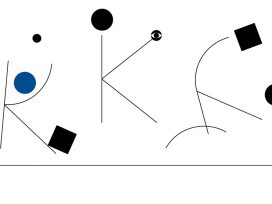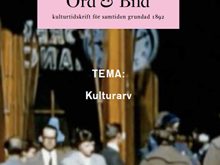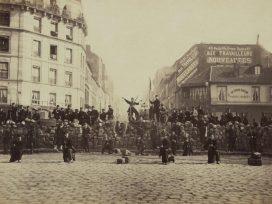The term is inspired by theories of Paolo Virno who uses the category of opportunism when analyzing post-Fordist production systems, oriented at flexibility, mobility and individualism. Following Virno’s traces I refer to the structural, non-moralistic definition of opportunism. Here opportunism does not mean an attitude that is morally doubtful, a lack of principles or the atrophy of one’s ethical spine. This notion rather connotes the fundamental dependence of individualized culture producers on the never-ending lookout for possibilities (moonlighting, projects, exhibition opportunities, orders or temporary employment). The thesis that I propose here is as follows: structural opportunism in a form of fundamental dependence of the otherwise independent (not undergoing the formal discipline of contract work) art producers on a permanent search for opportunities; it is the source of systemic pressure that leads to the popularization of competition, the instrumentalization of social relations or, last but not least, the atomization and self-precarization of art workers. In the conclusion of this article I shall draw your attention to the resistance originating from structural opportunism. Its key aspect is a contestation of individualized dependency on the flow of opportunities.
Transformations of the field of art
The main task in the category of structural opportunism is accounting for the transformations that are currently taking place in the methods of organizing life and work of artists, curators, producers, assistants, art theorists and other professional groups present in the artistic work. My argument is therefore based on the assumption that currently such transformations are taking place. The thesis of the fundamental transformation of the field of art is supported with a range of other sociological and theoretical studies.
It is also supported by my personal research on the practical and theoretical area of art where I attempted to analyze the role of the design and network-related arrangement of artistic production.
Similar conclusions were also drawn in studies conducted between 2013 and 2014 by a team at the Free/Slow University of Warsaw. The studies regarded a division of work and capital in Polish visual arts.
As a result of the research by the Free/Slow University of Warsaw, as well as my own observations, everybody currently in the field of art is circulating and is aware of the significance of being in this flow. Paraphrasing one of the respondents in the study conducted by the Free/Slow University of Warsaw: “if you are visible, you exist; if you are not, you cease to exist”.
In this arrangement of art circulation, you do not only create pieces of art but first and foremost compete for access to opportunities, such as projects, exhibitions, orders, moonlighting, and full-time positions that keep you in the circulation and ensure your visibility. The previous organization of institutions, social roles and justification systems do not so much as disappear but are rather subject to the processes of hybridization, inevitable transformations where it is structural opportunism that is setting the tone.
The world of art is evolving towards the hybrid system where networks and projects are mutating concepts and institutions of the autonomic field of art in the way that was analyzed by Pierre Bourdieu . Here an important role is played by the acceleration of the rhythms of artistic production, revaluation of works of art and methods of the building of an artistic trajectory. Luc Boltanski stresses that at present we are dealing with a shift from an “internal” to a “capitalist” method of artistic production.
The traditional model of artistic production, according to such sociologists of art, as Bourdieu, Cynthia and Harrison White or Howard Becker, were based on the system linking an artistic studio, an art gallery and a collection, the figure of an artist, the merchant, the critic and the collector, as well as the justification systems characteristic of the autonomic field of art (the concept of genius, sacralization of talent and a work of art). This arrangement works relatively slowly. It might take years or decades between the moment of creating a work of art before its recognition by critics or collectors. Artists build their reputation on a long-time basis while strategically accumulating the symbolic capital which Bourdieu defines as an autonomic value based on a negation of values against the area of external arts (the economic value, power, quick fame). Only in the long term can the symbolic capital be exchanged for social recognition, positions, status and income. According to Boltanski, at the moment the time perspective necessary for creating and estimating the symbolic value is shrinking dramatically.
The global circulation of art with its multiplication of transactions, an extremely fast pace and a speculative approach resembles the financial markets. Boltanski writes mainly about the global market of art; his remarks, however, regarding less time and the related fundamental transformation in production methods, might be applied more generally to the current state of art circulation. This transformation takes place not necessarily because it is influenced by market speculations, but more so thanks to global networking and the popularization of project production systems. In this context, Boltanski’s perspective is worth enriching or modifying by referring to an analysis of “creativity plants” conducted by Gerald Raunig. He discusses how the methods of organizing space and time, which are specific to creativity plants, chop, cut and smooth employees’ time so that they are controlled and exploited while, at the same time, enthusiasm is generated.
Apparatus of structural opportunism
In the methodological sense when Boltanski is asking himself a question regarding the value of a work of art, Raunig is thinking about the methods of organizing production time and modulations of subjectivity and this thinking does not lie far from the perspective outlined here. Structural opportunism arranges social relations in art circulation by making art employees dependent on searching for opportunities, regulating their flow and controlling access to them. It impacts institutional models; it defines career paths; it modulates subjectivities, values and beliefs. Let me refer here to the category of apparatus (French dispositif ) which was developed by Michel Foucault and whose prototype version can be found in Walter Benjamin’s works. Pieces of apparatus are devices used for artistic production, resources and institutions that facilitate the creation and distribution of art while, at the same time, formatting the information regarding what, how and by whom is created, distributed and consumed. They are codifications of social relations and material implementations of the codes. Pieces of the apparatus modulate circulation of social energy and define the shape taken by sets of heterogeneous elements they arrange. At the same time, pieces of the apparatus are not deterministic; they are always created at the nexus of power and resistance or the notion that Foucault names the strategic function of the apparatus and the methods of its contestation”.
If we refer to the concepts by Gilles Deleuze and Félix Guattari, the pieces of apparatus, similarly to arrangements, are always defined by their output lines while their mutating forms are described by the direction of flows that destabilize them . The pieces of apparatus that are specific for structural opportunism are fundamentally ambivalent and in this ambivalence they are not different from other social pieces of apparatus. On the one hand, they are progressive and generative. They ensure flexible production systems that facilitate creation of work or organizing projects; they provide access to opportunities and sustain individual freedom and mobility. On the other hand, in a specific way they format the lives and work of participants of artistic circulation while controlling independent art producers and causing their self-precarization, which leads to the situation in which they must compete with each other or change into micro-entrepreneurs.
Theoretical background of the term of structural opportunism
The category of structural opportunism originates from the intellectual tradition of Italian post-Marxism. The models built around other terms that emerged from this tradition, such as “immaterial labor”, “precarity”, “creativity plants” tend to be applied in art theory They serve a dual purpose, namely: they account for transformations taking place in late capitalism which popularizes flexible production methods and, as a result, creates and commercializes not only objects but also symbols, affects or lifestyles. These notions also help us to undertake an adequate analysis of transformations in the field of art which is losing its autonomy while its characteristic creativity is becoming “industrialized”.
The theory built around structural opportunism is materialistic to the core. The area of art is analyzed here as if it were a peculiar “social plant” with its characteristic division of labor, distribution of capital, relations of power and exploitation. Thus, I refer here to a work by Walter Benjamin who outlined this materialistic perspective in his famous essay entitled Twórca jako wytwórca (also translated as „Autor jako producent”. In this essay he suggests that in order to understand the situation of intellectuals one shall not analyze what they say about the relation with production of their time, but rather look closer at the position they occupy there.
The theory of structural opportunism, similarly to other post-Marxist models, questions the ideological naturalizations of the traditional division of artistic work (between the creator, the curator and the assistant, etc.); it also demystifies the fundamental sacralizations (works of art, the figure of the creator) for functioning of the field of art; it has strong doubts about justifications and rating systems (the categories of talent, the aesthetic value, and taste) that are common in the field of art. This approach is complementary to the critical sociology of the field of art whose representatives, such as Pierre Bourdieu, Howard Becker or Cynthia and Harrison White have already been quoted here. It points to the social empowering of values or conventions that are specific for the field of art.
Structural opportunism
Despite the fact that the category of structural opportunism comes from from the same root as such terms as precarity or immaterial labor, it is more powerful in terms of accounting for the current transformations in the field of art. It helps explain the constant pressure put on the individuals who are a part of the artistic circulation, as well as identify the resistance mechanisms that the pressure triggers.
Contrary to the more general term of immaterial labor, the theory of structural opportunism omits the discussion on “materiality” of existing labor forms or its commodities. It is based on a vague division into “material” and “immaterial” labor (the same issue is raised by Maurizio Lazzarato, one of the creators of the term. Instead of deliberating whether work in the field of art is more or less material than labor in an “ordinary” plant, the notion of structural opportunism points to much more important changes on the labor market that are related to more flexibility. In a situation where an employee or an artist has no job security in the form of a stable source of income, they are forced to compete for the shrinking range of opportunities (whether permanent positions or artistic projects). Deprived of permanent income, art producers become, according to Pascal Gielen, “happy nomads”, opportunistic and cynical creatures who wander from one project to another, with no baggage of principles or responsibilities.
In its otherwise accurate criticism of cynicism and opportunism, Gielen leans towards the moralizing definition of these terms. His observations are inspired by Virno’s thoughts. However, Gielen himself seems not to notice that opportunism is of a structural nature and it is a systemic dependency between atomized individuals on the flow of always ephemeral opportunities. According to Virno: “the roots of opportunism must be sought in socialization which is external in relation to the workplace and marked with unpredictable shifts, perception shocks, permanent innovation and a chronic lack of stability. Opportunists are people who confront the permanent flow of opportunities which are always exchangeable; they make themselves available so that they could use as many as possible; they lean towards the closest one and then quickly bounce towards another one.
The necessity to grasp every opportunity (employment, a project, income) that helps one to survive is the wellknown state both for employees operating on the flexible labor market and the participants of the artistic circulation. Nothing is given once nor forever. Every opportunity has to be fought for. In this sense, opportunism is an indispensable part of life and work in the capitalism of networks rather than a moral shortage of anyone.
Virno stresses that opportunism, which is structurally induced, is connected with two other factors, namely: fear and cynicism. Opportunism is laced with cynicism since in the case of common mobility, the principles of equivalent exchange are getting weaker and every normative arrangement is perceived as arbitrary. Virno writes: “A cynic recognizes their reflection in all ‘games’ deprived of dignity and obviousness while becoming no other than spaces of immediate self-affirmation”.
Striving to achieve personal success, often at any cost, is however determined by fear. According to Massimo De Carolisa, a philosopher and theorist of opportunism, “the dominant sentiment […] among opportunists is nothing else but dread, fear of an animal on the run”. It’s an animal fear of survival, an existential fear triggered by a lack of stable income.
Control
The theory of structural opportunism helps to account for such key issues related to being in circulation, as: self-control, capitalization of oneself and self-precarization. Due to the structural dependency on the flow of opportunities, “independent” culture producers are subjected to a range of forms of dispersed control. Artists or curators do not need to be subject to direct discipline in order to act in line with the systemically agreed principles of structural opportunism. They are not told to apply for projects; neither are their work processes directly monitored. Yet still, as shown in the research conducted by the Free/Slow University of Warsaw, they have a tendency to sacrifice themselves for the sake of their projects, to apply constantly and work too much. This tendency can be understood slightly better by referring to the remarks by Gille Deleuze about the societies of control. Societies of control force individuals to undergo “a seemingly liberating, ultrafast form of control that replaces the old techniques of discipline functioning in the rhythm, characteristic for closed systems”. In such societies, people control themselves and each other. In societies of control the authority not only settles down in various disciplinary locations (such as schools, hospitals or plants) but it rather penetrates all social relations. Control means power and it is more effective due to it being dispersed, hence difficult to contest. Still, the essay by Deleuze is a thorough description of the situation rather than an attempt to explain how and why this system of dispersed power works. Here the category of structural opportunism might help. Access to opportunities is regulated via the apparatus embodied in social forms of the institution of art, international art events or grant systems. They control access to opportunities which is regulated via their specific selection mechanisms which are more or less formalized preference systems. In the case where every participant of the circulation is forced to incessantly search for opportunities (exhibitions, projects, orders), access to them comes at a price of meeting the requirements of the pieces of apparatus that provide them.
And yet for instance, the availability of grants often constitutes a sufficient incentive for undertaking artistic activity that would never otherwise occur. In this case we are dealing with self-control of seemingly independent culture producers who, not being subjected to the labor discipline, implement the objectives of historical policy or cultural diplomacy. Similar mechanisms also work in case of other pieces of the apparatus of artistic circulation. The stronger control there is the more competitive access to opportunities there is. The more art workers must compete with each other, the faster they meet the requirements of institutions or people who regulate the access to the opportunities. Non-conformism comes at a price of being excluded from the circulation.
Competition
It must be stressed that pressure on competitiveness is the fundamental characteristic of structural opportunism. Participants of the circulation are forced to compete for access with other circulating art producers, since there are always fewer possibilities than those wanting to make use of them. Moreover, even if every project is the result of collective cooperation, they are individual units, rather than communities circulating among them, which causes nomadic circulation and extreme individualism. Pascal Gielen criticizes the world of networks because of the fact that in the race for opportunities, everyone participates alone against everyone else. In this world, associations or trade unions are replaced with cliques which do not stand for solidarity but are a vehicle of collective selfishness.
The allocation of opportunities is not coincidental. According to Luc Boltanski and Eve Chiapello, the authors of The New Spirit of Capitalist, a systemic analysis of network capitalism, the moment between one project and another is a test of individual agility. In such moments, the individual ability to enter into further projects is tested. Access to opportunities derives from an individualized reputation, visibility in the circulation, the quantity and quality of social contacts, knowledge and experience. Such profiles are subject to dynamic changes; they are not set once and for all and have no tendency to accumulate in time as it took place in case of symbolic capitalism.
Everyone is as good as their latest project and, moreover, the circulation is characterized by a great amount of uncertainty and temporariness, which only contributes to increased pressure on competitiveness and increased atomization.
Self-entrepreneurs
The production system which is oriented at competitiveness and individualism places subjectivity of its participants in line with neoliberal models of subjectivity. Individuals who compete for opportunities, either in artistic circulation or on the flexible labor market are forced to become “self-entrepreneurs” or “micro-entrepreneurs”. As Boltanski and Chiapello noted, when referring to studies by Pierre-Michele Menger regarding the art labour market, artists today become micro-entrepreneurs who build the market portfolio, calculate the risk and strategically manage their own professional career. In accordance with the theory of structural opportunism, accepting micro-entrepreneurial strategies by producers is the result of the necessity to constantly compete for opportunities.
This state of affairs forces capitalization of reputation, social contacts, experience, and one’s own affects. They must be invested in order to gain access to opportunities. As a result of structural pressure, individuals competing for opportunities undergo a transformation into their own entrepreneurs. With the help of this notion, Foucault analyzed neoliberal models of subjectivity. According to Foucault, a self-entrepreneur “is their own capital, their own manufacturer, their own source of income”. A self-entrepreneur is strongly committed to achieve success and fully engages themselves in this enterprise while transferring their knowledge, feelings, social contacts, or their reputation into their capital. A tendency for accepting neoliberal models of subjectivity must be understood in the category of the systemic pressure exerted by structural opportunism. It is not an inherent condition of artists or the result of lack of character but rather the mechanism of power. As such it is triggering criticism and resistance of the interested parties, such as Rebecca Gordon-Nesbitt or the Berlin- based group Haben und Brauchen that validly deconstruct mini-entrepreneurship as the ideological product of neoliberalism.
Self-precarity
Regardless of whether this criticism is justified or not, the categories of structural opportunism and micro-entrepreneurship help us understand such phenomena as self-precarity, which is the tendency characteristic for artistic circulation to select uncertain and extremely risky career paths. As it is argued by a group of individuals on the artistic left who often find support in the post-Operaismo theories quoted above, contemporary art workers are members of the precariat. Their situation might be understood in the context of a broader social problem in the form of job uncertainty and the temporariness of employment as well as a worsened situation of employees. This problem is analyzed by a range of activists and theorists, also in Poland.
It is difficult to argue that the life and professional trajectories of individuals present in artistic circulation are characterized by a very high level of living uncertainty, no social insurance or simply poverty. On the other hand, however, there are fundamental differences between precarity of art people and workers on the lowest levels of the employment hierarchy. Self-precarization of culture producers is discussed by Isabell Lorey, a social philosopher. According to her, they treat uncertainty as included in the cost of building an individualized trajectory while they agree for exploitation or relative poverty. Andrew Ross, a sociologist, argues that in the case of artists or other “white collar” workers, we are dealing with precarity of choice. The necessity to always claim temporary opportunities is understood as one’s freedom of choice, investing in one’s own trajectory. It is compensated by the vision of promotion and individual success. For the mechanics of desire and aspiration, it is of little importance that in case of most competitors this success might not come. Its very vision justifies certain sacrifices which are treated as temporary, as emphasized in the study of creative industries by Angela McRobbie. Such members of the precariat still maintain a sense of empowerment and that the shared uncertainty is the consequence of their individual choice. Also in the studies by the Free/Slow University of Warsaw, despite frequently stressing precarity, respondents maintained a high level of optimism, which can also be related to their more privileged social position or other life trajectories.
Arranging the circulation in line with structural opportunism is a reason for this state of affairs. Access to opportunities is related to the reputation or visibility which, in turn, seems to be the effects of individual effort. This system of arranging the circulation leads to the situation in which unpaid artistic activities are regarded as an investment strategy which, in the longer term, might bring a “profit” in the form of access to opportunities. However, due to systemic constraints in access to opportunities there are much fewer opportunities than individuals who want to use them, much more frequently this involvement fails to bring the expected results.
Not winning the race for opportunities results in depression. McRobbie and other theorists of post-Fordism such as Franco “Bifo” Berardi point to the fact that depression is a professional disease of the creative industries. According to Berardi, “current social norms do not accept the possibility of a failure […] while there is no competition without failure and losing. However, the social norm cannot accept that a failure is normal without questioning its own ideological foundations, even denying its own economic effectiveness”. Structural opportunism makes individuals who independently compete for access to opportunities take responsibility for the systemic constraints. The dark side of micro-entrepreneurship is the individualization of risk. Its side effect is depression, which is the condition of the sense of inability, inadequacy and futility of all efforts.
Conclusion
I wish to stress one more time that when writing about structural opportunism I mean the systemic arrangement of the artistic circulation. I focused deliberately on the description of negative aspects of this arrangement, such as self-precarization, micro-entrepreneurship and self-control in order to highlight the influence that structural opportunism has on the lives and work of individuals in the artistic circulation. Yet, inherent pressures on this arrangement of circulation must be understood as the sources of potential resistance. Participants of artistic circulation do not necessarily agree for opportunist arrangement of their world. They do not wish to compete with each other. They do not consider themselves to be a form of capital. They get tired of uncertainty. They suffer from depression. As I argued in a different paper, accepting a structural non-moralizing definition of opportunism is the starting point for shaping radical forms of opposition to this way of organizing work and life in circulation.
In the context of thinking about tactics of resistance I uphold the therapeutic guidelines of Berardi who calls for critical opposition to creative industries to be involved in the political therapy. It would aim at breaking down the obsession with the individualization of success which de facto leads to the privatization of a systemically induced failure. He claims that the flow of desires should be collectively deconstructed and reconstructed so that “the new libidinal investments would become possible and autonomic in relation to competition, possessiveness, acquisition and accumulation”.
Taking into account structural opportunism, any therapy deals with individual addiction to the permanent flow of opportunities. And since in this way, the authority is implemented, hence in the same way its opposition must be formed.






